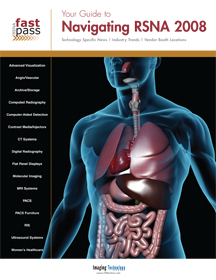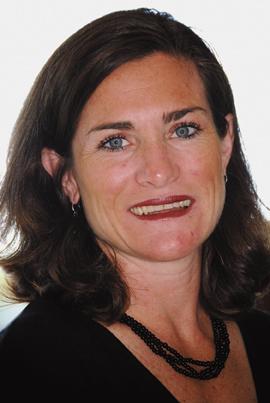
With an entire new wing added on to this year’s RSNA annual conference, finding seminars, courses and workshops, key vendors or even wireless zones will be a bit more challenging this time around.
But don’t worry. Tracking down new technology at RSNA just got a lot easier with ITN’s online RSNA FastPass at www.rsnafastpass.com/rsna2008 and its print version available at our booth #6811. From there, drill down to find the latest advances in CT, MR, PET, ultrasound, FFDM, breast MRI, X-ray and flat panel imaging, in addition to PACS, RIS, 3D imaging and more radiology IT solutions. The RSNA FastPass supplement also gives you insight into the prospective growth of the imaging market. Get a sneak preview of market trends in this issue’s article Imaging Recovers in 2010.
ITN’s online RSNA FastPass will continuously update you on the highlights and key data released from the scientific papers, posters and educational exhibits throughout the conference.
From the research released at RSNA, you can expect to learn about significant advances in breast imaging, such as defining breast cancer risk and selecting patient-specific screening strategies. Several papers were also submitted on radiation dose and technique development for cardiac CT. Researchers will impart results from studies on characterizing bone and soft tissue tumors using advanced MR techniques like diffusion imaging and spectroscopy.
Subspecialty focuses cover chest imaging and its continued interest in pulmonary emboli and nodules; CT colonography as a viable screening study for polyp detection; and studies on diffusion-weighted imaging of masses in the kidneys, ovaries and prostate.
Attendees will be introduced to new MR molecular imaging methods, multimodal agents, the use of fluorodeoxyglucose PET to predict cardiovascular risk, plus a new PET tracer to assess innervation and increased use of MR smart agents.
Highlights in nuclear medicine encompass new techniques in PET imaging with respiratory gating and new hybrid technology such as gamma ultrasound.
Groundbreaking research on the linkage of gene expression to tissue characterization is an important topic in which the morphology visible on cross-sectional imaging exams was compared with genetic markers of renal cell cancer.
The field of radiation oncology will benefit from focus sessions on important developments on consolidative radiotherapy for non-Hodgkin lymphoma, hepatic arterial embolization to predict distribution of therapeutic dose and immunomodulator therapy to enhance radiotherapy response.
Medical imaging informatics also plays a larger role in this year’s scientific seminars, with special emphasis on quantitative imaging, structured reporting, decision support tools and business intelligence and data analytics.
Be sure to map out your plan before the show by consulting RSNA FastPass at www.rsnafastpass.com/rsna2008.


